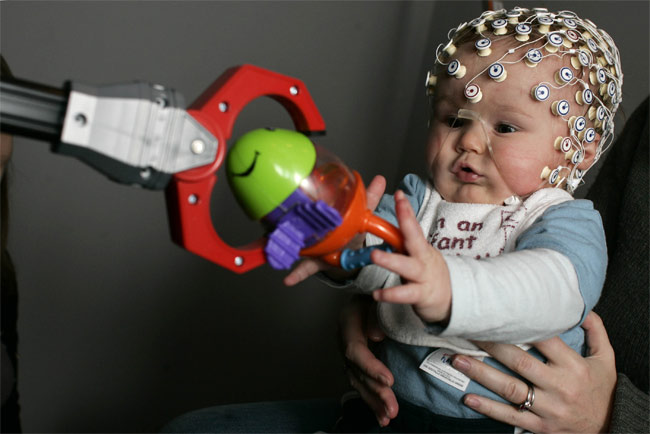Babies' Brains Churning With Activity

The look of amazement in the eyes of an infant suggests the wheels are churning away inside that noggin. New research confirms they are. Scientists have shown that when 9-month-olds watch people reach for objects, the motor region in their brains gets activated, as if the babies were doing the reaching themselves.
The brain ability is likely due to so-called mirror neurons, which fire both when we do an action ourselves, and when we watch others do a similar action. While such neurons have only been directly measured in monkeys, scientists think they exist in adult humans, and now in infants.
"Even in the first year of life, babies are using the area of their brain that is involved in their own motor skills, in order to help them perceive other people's actions," said lead researcher Victoria Southgate of the Center for Brain and Cognitive Development, Birkbeck, University of London.
Southgate and her colleagues attached electrodes to the heads of 15 nine-month-old infants in order to record brain activity while the little ones were performing or watching an activity. The electrodes were connected to encephalograph (EEG) machines.
In the first experiment, the infants sat in front of a puppet stage with the curtains closed. A mechanical claw holding a toy was held out through the curtain. After the infant briefly played with the toy, a scientist sitting next to the infant retrieved the toy.
In the next experiment, the curtains opened to reveal a small object on the stage floor. After less than a second, an experimenter's hand reached through the curtain, grasped the object and removed it from the scene.
The EEGs showed activity in the baby's brain when the experimenter grabbed for the object, similar to the activity found for the baby's own motion toward the toy. In addition, in later trials once the babies had observed the experimenter grabbing the toy, this brain activity also occurred just prior to such action.
Sign up for the Live Science daily newsletter now
Get the world’s most fascinating discoveries delivered straight to your inbox.
"The fact that the brain activity in babies is 'predictive' — it occurs when the baby can predict that someone will reach for an object — suggests that babies (and probably adults too) use their own motor system in order to figure out how someone else's action will unfold," Southgate told LiveScience. "That is, by accessing your own motor plan for how you would, for example, achieve the goal of picking up an object, you can make a good prediction about how someone else would also do that."
That information would help you to respond to the other person's action, say, to intercept their movements and take the object yourself, Southgate added.
And the brain activity could be one of a baby's first steps into the social world.
"For babies, this kind of brain activity may form the basis of their abilities to begin to engage in collaborative activities with others, which is likely to be an important part of their enculturation," Southgate said.
The study is detailed in the journal Biology Letters.
- Video – How Babies Learn Music
- More Baby News & Information
- Top 10 Mysteries of the Mind
Jeanna Bryner is managing editor of Scientific American. Previously she was editor in chief of Live Science and, prior to that, an editor at Scholastic's Science World magazine. Bryner has an English degree from Salisbury University, a master's degree in biogeochemistry and environmental sciences from the University of Maryland and a graduate science journalism degree from New York University. She has worked as a biologist in Florida, where she monitored wetlands and did field surveys for endangered species, including the gorgeous Florida Scrub Jay. She also received an ocean sciences journalism fellowship from the Woods Hole Oceanographic Institution. She is a firm believer that science is for everyone and that just about everything can be viewed through the lens of science.









